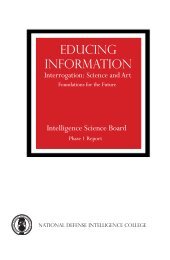COURTING A RELUCTANT ALLY - National Intelligence University
COURTING A RELUCTANT ALLY - National Intelligence University
COURTING A RELUCTANT ALLY - National Intelligence University
- No tags were found...
You also want an ePaper? Increase the reach of your titles
YUMPU automatically turns print PDFs into web optimized ePapers that Google loves.
FOREWORDTo most Americans alive today, the close alliance between the United Statesand Great Britain seems to be a “natural” thing, perhaps the inevitable expressionof what Winston Churchill referred to as the “special relationship” occasioned by“underlying cultural unity.” There are now few among us whose memories goback to the period between the two world wars and who would be able to pointout that, commonalities of language and culture notwithstanding, today's specialrelationship between the United States and Great Britain is a quite recent phenomenon,really dating only from the 1940-41 timeframe.For much of the two and a quarter centuries of our independence, relationshipswith Great Britain have been cool or even strained. Cooperation and intelligencesharing with the British in World War I was late in coming and limited inscope. At the end of the war, it slowed to an almost imperceptible trickle, and wasvery slow to resume. The author outlines the factors accounting for the reluctanceof both sides to share information and the underlying feeling of competitivenessbetween the Royal Navy and the U.S. Navy during the interwar years. This hadmoderated by the outbreak of hostilities in 1939, but within a year two differentdynamics had arisen: the American concern after the fall of France that the Britishmight be quickly defeated, and thus US technical and intelligence informationcompromised; and the British single-minded focus on bringing America into thewar and gaining access to our vast technological and industrial resources. To furthertheir goals, the British were willing to provide the United States with virtuallyunlimited access to British secrets — technological as well as intelligence —even without any quid pro quo. Their strategy worked. The author outlines howthe exchange of information started as a trickle, turned into a flood, and enduresto this day.Most books dealing with U.S.-British cooperation during World War II naturallyfocus on the war in Europe and highlight the great British cryptologic successwith the German Enigma codes (actually a Polish-French-British success).Many leave the reader with the impression that the United States, in gainingaccess to Enigma decrypts and Royal Navy operational intelligence techniques,got the better half of the bargain. But this is far from a complete picture. It wasthe Americans who broke the Japanese diplomatic codes and gave codes andmachines to the British, and the Americans who provided the bulk of the effortand success against JN-25, the Japanese navy operational code, although British,Dutch, and Australian cryptanalysts contributed significantly during the war.American scientists and laboratory-industry efforts significantly upgraded thetechnology used to break Enigma codes. Also, OPINTEL, as it exists in the U.S.vii
















